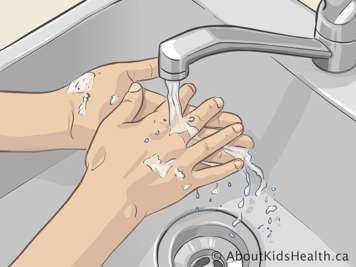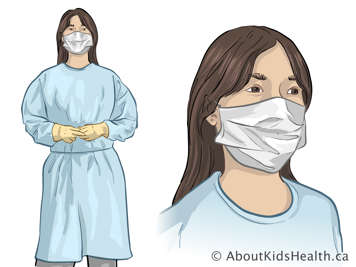If your child's hazardous medicine comes in an injectable form that can be given by mouth using an oral syringe or a cup, follow these instructions.
What is hazardous medicine?
Hazardous medicines are used to treat a variety of medical conditions. For example, chemotherapy is used to treat cancer, and immunosuppressants are used to prevent organ rejection after a transplant.
Hazardous medicine can damage healthy cells. Anyone handling hazardous medicine should keep themselves protected.
Although the risk of harm from handling hazardous medicine is small, it is a good idea to avoid exposure. This includes not tasting your child’s medicine. If you are pregnant or breastfeeding, it is best to avoid contact with hazardous medicine. If possible, have someone else prepare and give your child their medicine.
For more videos on how to safely handle hazardous medicines, please view the
Safe Handling playlist.
Preparing the space
You will need to gather certain supplies and take careful steps when setting up your work area. Your child’s health-care provider will help you make a list of the supplies you will need. You can buy these materials at a grocery or drug store.
To handle your child’s hazardous medicine at home, choose an uncluttered counter or table away from windows, fans, vents, areas where you prepare food, and where children and pets play.
If you are giving your child their injectable medicine by mouth, a gown, mask and gloves offer protection. Other supplies will include:
- paper towels or a disposable, absorbent plastic-backed mat — to contain any spills
- medicine vial
- a syringe — to draw up medicine from the vial
- a vial access device (vial spike) — to allow safe removal of medicine from the vial
- a container with a lid or plastic bag — for disposal of the syringe, vial and spike
- a suitable drink. Your child’s health-care provider will tell you which drinks are suitable
- a labelled container — to place any unused mixed medicine
- a medicine cup or labelled cup — used only for giving the medicine
Giving your child the injectable medicine by mouth
Always prepare the medicine right before your child will take it. Never prepare and store the dose ahead of time.
Before giving your child their medicine:


- Wash your hands with soap and water.
- Put on your gloves, gown and mask.
- Place paper towels or a disposable, absorbent plastic-backed mat over your work surface.
Giving the medicine
If your child’s medicine is suitable to be mixed with liquids, put some of the drink into the medicine cup and set aside. You will need to add at least an equal amount of the drink to improve how the medicine tastes.
Only some medicines can be mixed with liquids. Your child’s health-care provider will tell you if you can do this with your child’s medicine. Ask your health-care provider which drink is suitable to mix with the medicine.
- Remove the plastic cap from the vial and place the vial upright on your work surface.
- Remove the vial spike from its packaging and take the protective cover off of the spike.
- Making sure the vial is upright, align the spike with the centre of the vial closure. Keep the spike straight and push it down firmly into the vial until the spike passes through the rubber stopper and the plastic "skirt" snaps onto the vial.
- Remove the syringe from its packaging. Attach the syringe to the top of the vial spike by pushing and twisting until secure. Turn the vial upside down and pull back the syringe plunger slowly to draw out the required dose. Your child’s health-care provider will tell you the required dose. If you need to push medicine back into the vial, turn the vial upright before doing so.
- Remove the syringe from the vial spike. You are now ready to mix the medicine.
- To give the injectable medicine by mouth you can dilute it in the syringe or mix it with the drink.
Draw some of the drink from the medicine cup into the syringe with the medicine and give it to your child. Whatever amount of medicine your child needs, you will need to add at least an equal amount of the drink to improve how the medicine tastes.
For example, if your child’s dose is 5 mL, you will need to add at least 5 mL of the drink. You can add more of the drink to the syringe if needed.
- Place the syringe into your child’s mouth, and slowly push the plunger to release the drink and medicine solution.
- If your child is unable to take their medicine from a syringe, you can dilute it with the drink in the cup instead. Push the medicine from the syringe into the cup with the drink.
- Stir with the syringe to mix the medicine and the drink together.
- Have your child drink from the cup, making sure they finish all the liquid in the cup. You may give them more of the drink afterwards.
- Once you are done, place the syringe into a container for disposal. You will use a new syringe every time you prepare a dose.
- The vial spike can remain in the medicine vial and can be used for other doses. Your child’s health-care provider will inform you how long you can use the medicine vial once it is opened.
Diluting the medicine in the syringe
Mixing the medicine with the drink
Store the vial upright, in a cool, dry place, protected from light. Use a new vial spike for each new medicine vial that you use. Discard the empty vial and the used vial spikes into the disposal container.
Speak to your health-care provider if your child is having trouble taking the medicine.
While preparing your child’s medicine, please remember:
- Use the oral syringe to give the hazardous medicine only. Do not use them for other medicines.
Clean-up and storage of hazardous medicines
Hazardous medicines should be handled safely. It is important to carefully handle the clean-up of the supplies and work area, and to dispose of wastes properly.
Remember these key tips for safe handling of hazardous medicines at home.
- If possible, avoid contact with hazardous medicines if you are pregnant or breastfeeding.
- You and your child should wash your hands before and after handling hazardous medicines.
- Wear gloves when handling hazardous medicine tablets, capsules, or liquids.
- Properly clean, dispose or store the equipment and hazardous medicine.
All disposable items that have been in contact with hazardous medicines, such as used paper towels and gloves, must go into a designated plastic waste bag or container. Contact the Household Hazardous Waste Depot in your neighbourhood to see if they will accept the waste bags or containers. If such a service does not exist in your area, ask a member of your child's health-care team about other options.
You may wash and reuse some of your supplies, but do not rinse them in the kitchen sink over other dishes or utensils.
If you are reusing an item, such as the medicine cup, rinse it with warm soapy water and allow it to air dry. Clean the sink after washing your supplies.
Always store hazardous medicines away from children and pets. If stored at room temperature, place them in a locked box, away from moisture and direct sunlight, and in a cool, dry place. If the medicine needs refrigeration, place it in a separate container at the back of the fridge. Return the medicine to the locked box or fridge after each use. Do not keep any medicine in your purse, knapsack or diaper bag.
Take special precautions with your child's waste (vomit, urine and stool) while they are taking hazardous medicine
While your child is taking hazardous medicine, some of the drug is broken down and removed from the body through urine and stool. It may also appear in vomit. It is important that you protect yourself and others from hazardous medicine in your child's urine, stool or vomit by following these guidelines:
- When changing your child’s diaper, wear disposable gloves and place diapers in a sealed plastic bag before disposal.
- If your child is toilet trained, have your child close the lid, to avoid splashes, and flush twice after using the toilet. Always make sure they wash their hands afterwards.
- Have supplies ready in case you need to quickly clean up any accident. You need a paper towel, soap and water, disposable gloves, and a disposable container, such as an empty ice cream container.
- Use a plastic mattress cover to protect the mattress from accidents.
- Keep a plastic container close by in case of vomiting. If you use the container, empty the contents into the toilet and wash with warm soapy water.
- Wear disposable gloves when you are handling any bodily wastes, such as changing soiled sheets or cleaning up vomit.
- Wash soiled clothes or sheets separately from other laundry. If they cannot be washed right away, place them in a sealed plastic bag and set it aside.
- Once you are all finished, wash your hands.